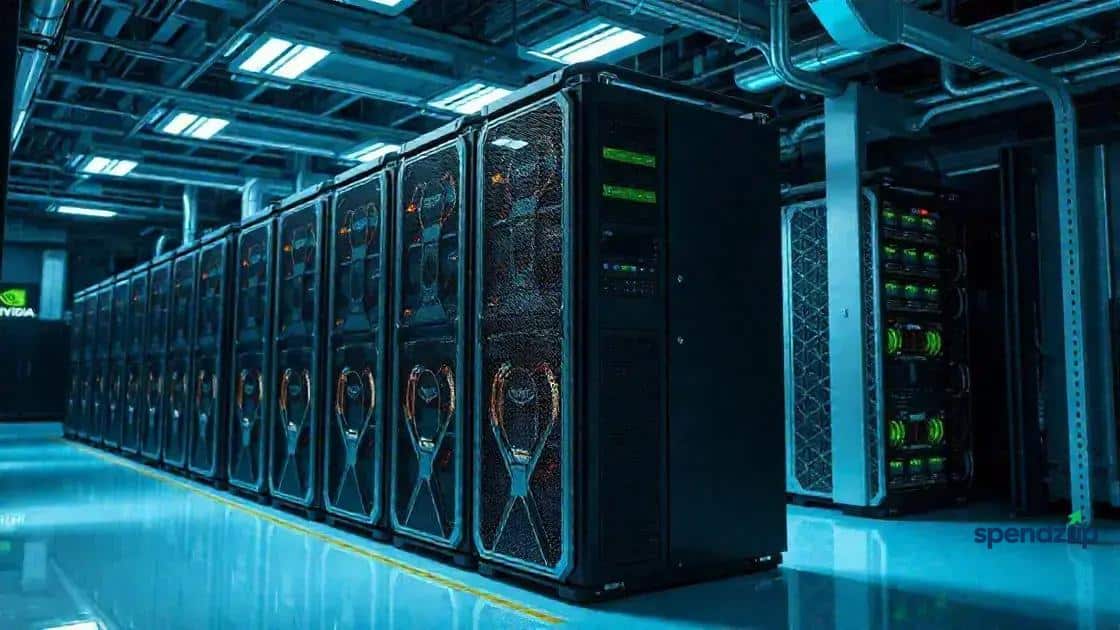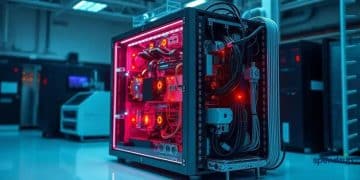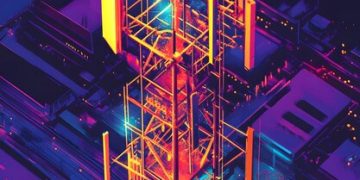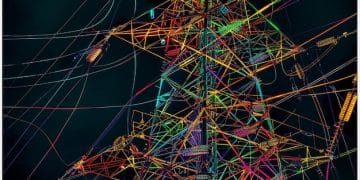Nvidia US supercomputers revolutionizing advanced computing

Nvidia supercomputers leverage advanced GPU technology to excel in AI and machine learning applications, providing unmatched processing power for complex computations across various fields like scientific research and climate modeling.
Nvidia US supercomputers are at the forefront of technological advancement, reshaping industries and enhancing research capabilities. Have you ever wondered how these supercomputers are impacting our world?
The rise of supercomputing in the US
The rise of supercomputing in the US has been remarkable over the past few decades. As technology advances, these powerful machines greatly enhance our ability to solve complex problems.
Supercomputers are now pivotal in various fields, including scientific research, climate modeling, and artificial intelligence. They enable researchers to analyze massive datasets and run simulations that would be impossible on standard computers.
Why Supercomputing Matters
Supercomputers serve as the backbone of modern scientific discovery. Their immense processing power helps in:
- Accelerating drug development and medical research.
- Predicting weather patterns with high accuracy.
- Understanding complex phenomena, from the cosmos to molecular biology.
The US has always been at the forefront of supercomputing, with institutions like Oak Ridge National Laboratory leading the way. These organizations continually push the envelope in computational capability.
Key Factors in the Rise
Several factors contribute to the increasing importance of supercomputers:
- Advancements in hardware technology, allowing faster and more efficient computations.
- The growing need for data analysis in various sectors, especially in genomics and climate science.
- Government and private sector investment in supercomputing infrastructure.
Furthermore, international collaboration plays a crucial role in advancing technology. Researchers from around the world share knowledge and techniques, leading to improved designs and efficiency.
The impact of supercomputing is far-reaching. From predicting earthquakes to modeling complex biological systems, the rise of these technologies has opened new frontiers in research and development.
Key technologies behind Nvidia supercomputers

The success of Nvidia supercomputers hinges on several cutting-edge technologies that drive their performance and efficiency. These innovations are at the heart of making advanced computations possible.
One of the most important components is the GPU, or Graphics Processing Unit. Designed for parallel processing, GPUs enable supercomputers to handle vast amounts of data simultaneously. This capability allows for faster calculations in fields such as deep learning and scientific simulations.
Advanced Architectures
Nvidia employs specific architectures that enhance the capabilities of their supercomputers. Some key features include:
- Tensile architecture: This technology improves memory usage and processing power.
- CUDA cores: Thousands of cores work in parallel to boost performance for complex calculations.
- NVLink: This high-speed interconnect allows GPUs to efficiently communicate with each other.
These technologies not only maximize the performance of Nvidia supercomputers but also reduce the time required for tasks that would take traditional computers much longer.
AI and Machine Learning Integration
Another significant aspect of Nvidia’s technology is its adaptation for artificial intelligence and machine learning. The architecture is designed to support various AI frameworks, making it easier for researchers to develop and deploy models. Nvidia’s platform provides:
- Deep Learning Libraries: These libraries offer optimized functions tailored for Nvidia hardware.
- AI Workflows: Supercomputers can rapidly process and analyze data, training AI models more efficiently.
- Real-time Analytics: Users can gain insights much quicker, enhancing decision-making processes.
The combination of these technologies positions Nvidia supercomputers as leaders in the field, offering unmatched performance for researchers and developers alike.
Applications of Nvidia supercomputers
The applications of Nvidia supercomputers span across many fields, showcasing their powerful capabilities. These advanced machines are essential in addressing some of the world’s most complex challenges.
In the field of scientific research, Nvidia supercomputers facilitate groundbreaking discoveries. For instance, they are used for simulating molecular interactions in drug development, significantly shortening the time needed to discover new medications.
Climate Modeling
Nvidia supercomputers also play a crucial role in climate science. They help researchers create detailed models of climate systems, leading to improved predictions of weather patterns. This capability assists in:
- Understanding the impacts of global warming.
- Planning for natural disasters with better accuracy.
- Developing strategies for minimizing environmental effects.
These applications in climate modeling demonstrate the potential for Nvidia supercomputers to impact real-world issues, providing data that can lead to actionable climate policies.
Artificial Intelligence and Machine Learning
Another vital area of application is in artificial intelligence (AI) and machine learning (ML). With their exceptional processing power, Nvidia supercomputers can handle vast amounts of data to train complex models. This enables advancements in:
- Image and speech recognition technologies.
- Autonomous vehicles and robotics.
- Natural language processing for more intuitive AI interactions.
In addition, industries such as finance and healthcare benefit from these developments. Faster data analysis allows for real-time decision-making, which can be critical in various situations.
Furthermore, Nvidia supercomputers support industries like entertainment and gaming, where advanced graphics rendering and simulation can elevate user experiences significantly. They create realistic environments that engage players in new ways.
Comparing Nvidia with other supercomputing leaders

When comparing Nvidia with other supercomputing leaders, it’s essential to consider various factors that influence performance, technology, and industry applications. Each company has its strengths, but Nvidia stands out in several key areas.
One major advantage of Nvidia is its focus on graphics processing units (GPUs), which excel at parallel computing. Unlike traditional CPU-based systems, Nvidia’s GPUs can handle multiple processes simultaneously, leading to faster calculations. This capacity is essential for tasks such as deep learning and complex simulations.
Key Competitors
Some of the major competitors in the supercomputing space include:
- IBM: Known for its powerful systems like Summit, which are highly scalable and often used in scientific research.
- Intel: A leading chip manufacturer that focuses on CPUs but has recently entered the GPU market to compete with Nvidia.
- Cray (HPE): Famous for its supercomputers, Cray combines innovative architectures and advanced interconnects.
While each competitor has unique features, Nvidia’s stronghold lies in its versatile software ecosystem, which supports various AI frameworks. This adaptability makes it easier for researchers and developers to leverage Nvidia supercomputers for a range of applications.
Performance Metrics
In terms of performance, benchmarks play a significant role in comparisons. Nvidia consistently ranks high in various benchmarks, especially in areas involving:
- AI training and inference.
- High-performance computing tasks.
- Real-time data processing capabilities.
The continuous improvements in hardware and software also contribute to Nvidia’s leading position. With frequent updates and innovations, Nvidia often stays ahead of the competition, meeting the ever-growing demands of modern computing.
Ultimately, while Nvidia supercomputers are often compared to others, their unique combination of GPU technology and comprehensive software support makes them a popular choice in many industries.
Future trends in supercomputing with Nvidia
The future trends in supercomputing with Nvidia are set to revolutionize how we approach technology and research. With rapid advancements in AI and machine learning, Nvidia is positioning itself at the forefront of this evolution.
One significant trend is the increasing integration of AI capabilities into supercomputing. Nvidia’s GPUs are already optimized for AI workloads, allowing for efficient data processing and enhanced machine learning capabilities. This integration opens new doors for industries like healthcare, where real-time data analysis can lead to faster diagnoses.
Quantum Computing Synergy
Another trend is the collaboration between supercomputing and quantum computing. Although still in early development, quantum computing has the potential to solve problems far beyond the capabilities of traditional computers. Nvidia is exploring ways to combine its powerful GPU technology with emerging quantum systems, paving the way for breakthroughs in various scientific fields.
Edge Computing
Edge computing is also gaining traction. As IoT devices proliferate, the need for processing data closer to the source increases. Nvidia’s supercomputers are expected to play a critical role in managing and analyzing this data effectively, providing insights with minimal latency. This trend will enable smarter cities and more responsive systems across multiple sectors.
Additionally, the focus on sustainability is transforming supercomputing technology. Nvidia is committed to developing energy-efficient solutions that reduce the carbon footprint of data centers. This shift towards greener technology reflects a growing awareness of environmental impacts within tech industries.
Finally, Nvidia plans to enhance its software ecosystem, making it more accessible for developers. By providing comprehensive tools and frameworks, Nvidia aims to empower researchers and engineers to innovate without barriers. As these trends unfold, the landscape of supercomputing is bound to shift dramatically, with Nvidia leading the charge.
In summary, the future of supercomputing with Nvidia looks bright
Nvidia is set to lead the charge in integrating advanced AI technologies, exploring synergies with quantum computing, and enhancing edge computing capabilities. Their commitment to sustainability and developer accessibility will also reshape the landscape of supercomputing.
These innovations will impact various fields, from healthcare to environmental science, making research faster and more efficient. As these trends evolve, the role of Nvidia in advancing supercomputing will continue to grow, paving the way for exciting possibilities in technology.
Embracing these changes means we can look forward to a future where supercomputing not only addresses complex challenges but also drives progress across multiple industries.
FAQ – Frequently Asked Questions about Nvidia Supercomputers
What are the main advantages of Nvidia supercomputers over others?
Nvidia supercomputers excel in parallel processing capabilities thanks to their advanced GPUs, allowing for faster calculations, especially in AI and machine learning tasks.
How do Nvidia supercomputers contribute to AI advancements?
Nvidia supercomputers are optimized for AI workloads, enabling efficient data analysis and model training, which leads to significant improvements in AI applications across various fields.
What is the role of edge computing in the future of supercomputing?
Edge computing allows data to be processed closer to its source, reducing latency. Nvidia supercomputers will manage and analyze this data effectively, enhancing smart technologies and real-time responses.
How is Nvidia addressing sustainability in supercomputing?
Nvidia is focused on developing energy-efficient solutions to minimize the carbon footprint of data centers, reflecting a commitment to green technology in supercomputing.





